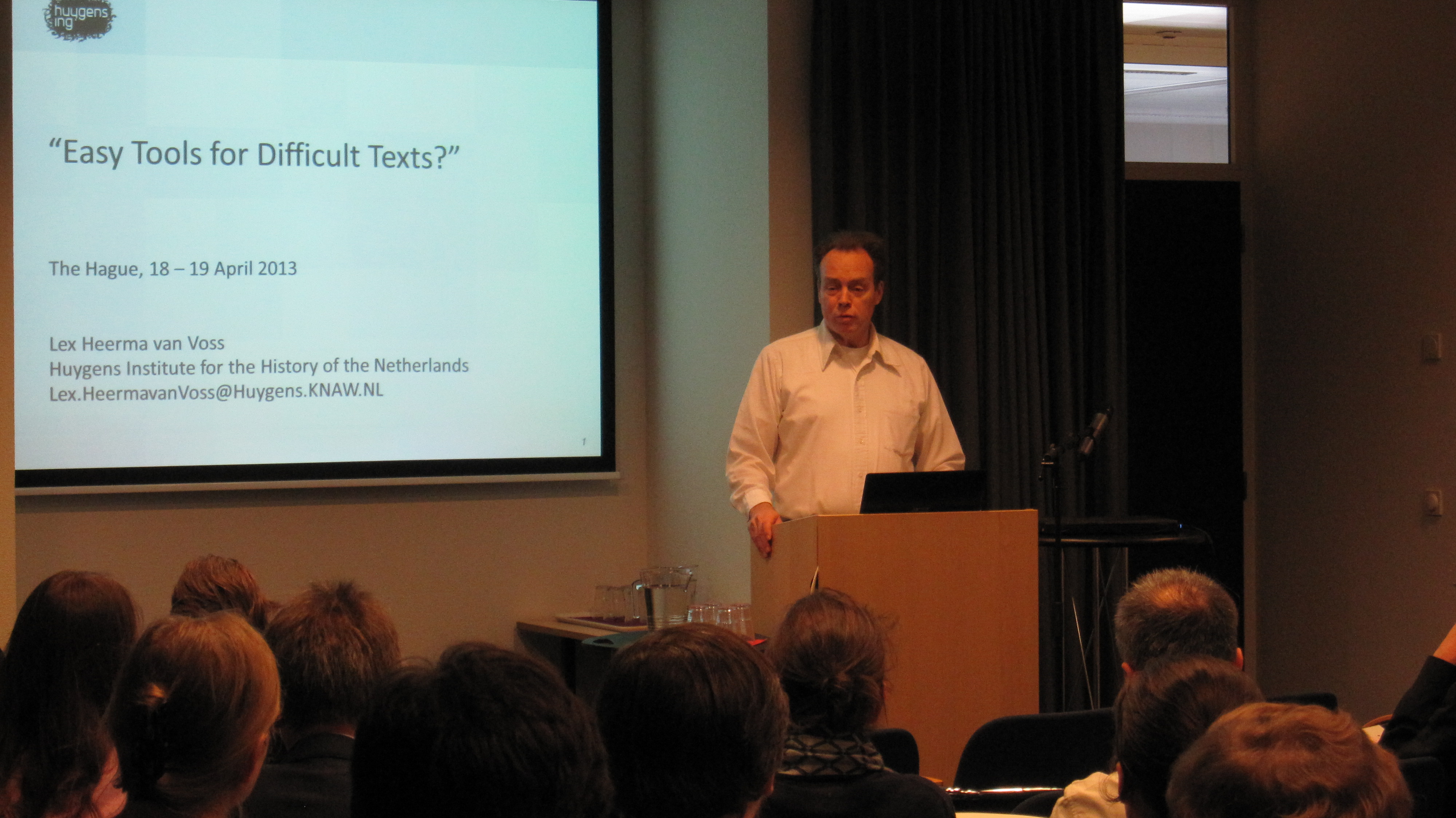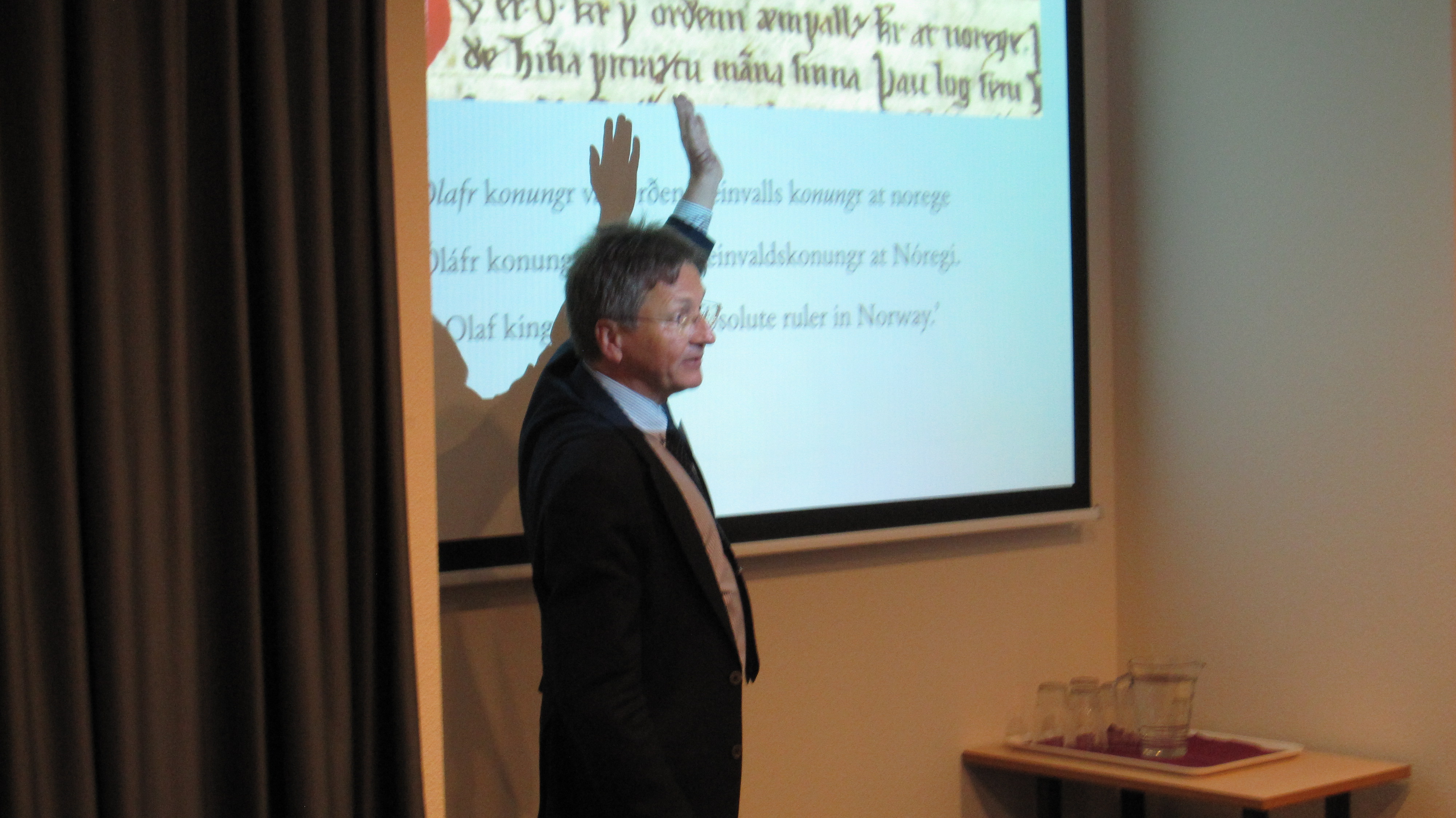 Delen via Facebook
Delen via Facebook Delen via Twitter
Delen via Twitter

Abonneer op RSS feeds
 Nieuws
Nieuws Agenda
Agenda Weblog e-tekstualiteit
Weblog e-tekstualiteit Achtergrond
Deze site is geinitieerd door:
Achtergrond
Deze site is geinitieerd door:
Report of a workshop organized by the Huygens ING within the framework of the COST Action ISCH 1005: Medieval Europe – Medieval Cultures and Technological Resources, 18-19 April 2013, The Hague.
As a Humanities scholar who is primarily a philologist and a historian, but otherwise underwent only little technical training in computing, I was very curious to attend the workshop ‘Easy Tools for Difficult Texts?’. What am I going to learn there, if my standard assortment of tools includes nineteenth-century paper editions, manuscripts catalogues and microfilms? Is it going to be comprehensible for a non-technical person like me, or addressed rather to the specialists who work in the field of digital humanities?
Digital Humanities is a young discipline, but one increasingly gaining prominence among the humanities scholars on account of the results computer-based approach brings when applied to the traditional subjects of scholars’ interests. Yet, it is in a way somewhat schizophrenic as it strives to bridge two fields that are distinct in their methodologies, goals and registers. The workshop title asked for tools that would be easy (to use and understand by their consumers, the scholars), but which can be applied also to difficult tasks (such as are envisaged by various specialized research teams across numerous fields within the humanities). I was pleased to see that ease of use, intuitiveness, and compatibility of data were among the themes resonating in various talks (Karina van Dalen-Oskam/Ronald Dekker, Tim Causer, Janina Jacke, Eugene Lyman, Roberto Rosselli Del Turco/Raffaele Masotti).

Other themes that emerged during the workshops were the use of crowd sourcing to enhance transcription process (Tim Causer), effective storage of large data that aims to allow for universal accessibility and manipulation (Michael Toth, Els Stronks), creating new modes of digital representation that go beyond static images or text files, and which do not operate with the basic, but often naïve assumptions about the nature of the objects that are to be represented (Robert Sanderson), new modes of presentation of data in the digital environment that can reflect our cognitive needs and predispositions (Eugene Lyman), linking the research data from various project by means of Semantic Web (Charlotte Tupman/Elvira Wakelnig, Aleksandrs Ivanovs/Aleksey Varfolomeyev), alternatives to XML encoding for data that is XML-resistant (Gregor Middell), new modes of data-visualization (Abigail Firey, Stefan Gradmann, Herman Brinkman), and computer-generated transcriptions that support querying through the objects handled in this manner (Jacques Savoy/Nada Naji).

Some of the presentations were concerned with introducing new or running text-related research projects employing digital tools, such as Schleiermacher in Berlin 1808-1834 project at the Berlin Brandenburg Academy of Sciences and Humanities (Stefan Dumont/Martin Fechner), Annotated Books Online at Utrecht University (Els Stronks), CATMA at University of Hamburg (Janina Jacke), the Parzival Project at Bern University (Michael Stolz/Reinhard Priber), the Edition Visualization Technology project at University of Pisa (Roberto Rosselli Del Turco/Raffaele Masotti), the projects concerned with linguistic evaluation of texts in Medieval Nordic Text Archive (Odd Einar Haugen), and of the Njál’s Saga (Ludger Zeevart), and the HisDoc Project developed by the university teams at Bern, Fribourg and Neuchatel (Jacques Savoy/Nada Naji).
While I must admit that I found it hard to follow the presentations at the workshop which were technical in nature, I was pleased to see the level of interconnection between the humanities scholars and computing experts that characterized some of the presenting teams and how such an approach made the topic presented more accessible to me. In many cases, the presentations were conducted by both a scholar and a computing expert that shared their time and represented perspective of interest of both parties. But perhaps the most welcomed and enriching element of the workshop were the demonstration rounds. In the course of these the participants of the workshop were able to put their hands on the tools discussed in the presentations while being maneuvered through their interfaces by the presenters, who answered their particular, tool-related questions. Thus, even in the case of tools, the technical complexities of which were beyond my grasp when presented on screen, I could grasp them by trying them and assessing them as a scholar, the potential non-specialist user.
http://easytools.huygens.knaw.nl/
[…] […]
[…] Lees verder op/ Read more on textualscholarship.nl […]